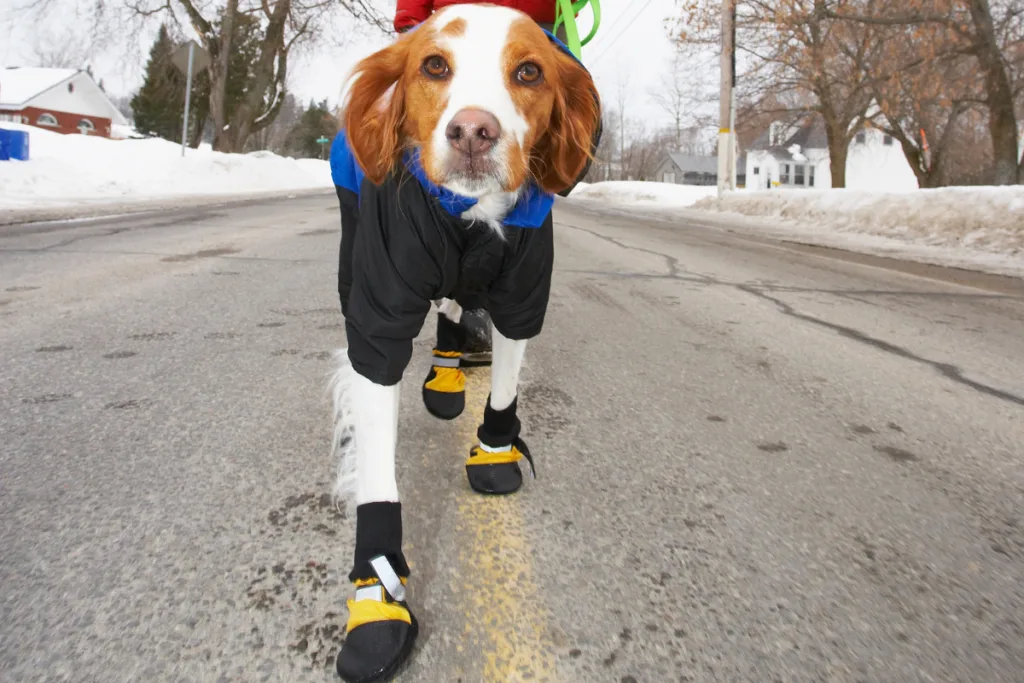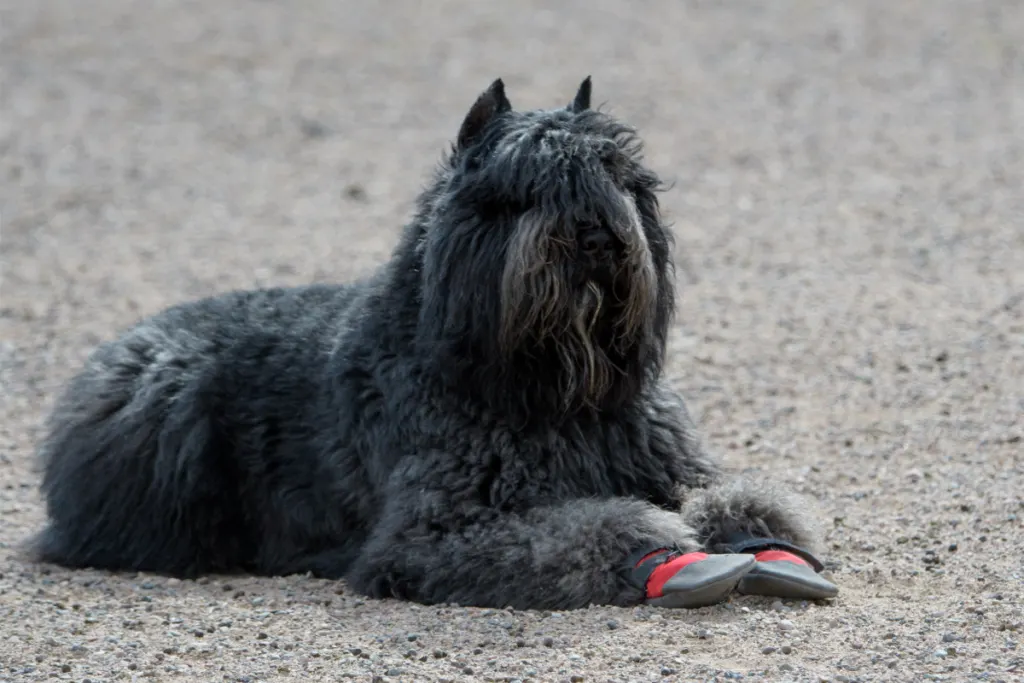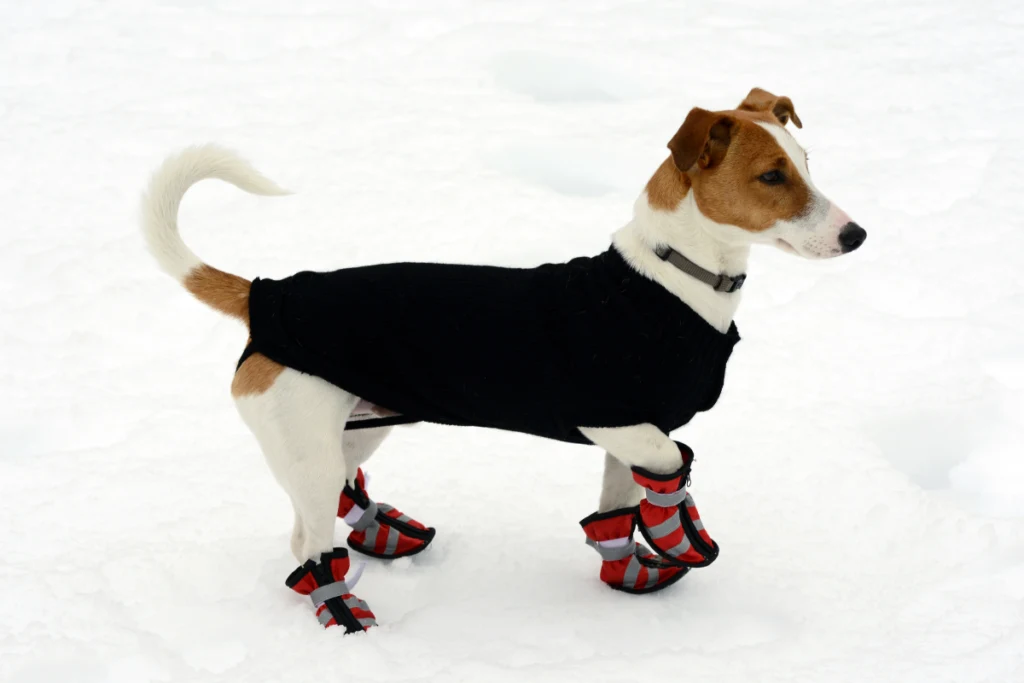Clothing for dogs has become a booming industry.
Pet owners spend hundreds of dollars on outfits for their dogs. Shoes are included in the ensemble and can be very costly.
While some people dismiss the idea of a dog wearing shoes as pure fashion, there may be a benefit to it in extreme weather.
Other people claim that dogs never need shoes.
The question needing an answer is whether dogs need boots for hot summers or those icy cold winters.

Dogs need summer boots for artificial surfaces, beach sand, and rocks when environmental temperatures exceed 85° F. Dogs can keep their feet warm in the cold but may need winter boots to protect them from snowmelt chemicals, salt, and extended exposure to icy conditions.
If you have ever forgotten your shoes at home and tried to run across hot paving, you will know how quickly your feet can burn.
Similarly, no one in their right mind goes hiking barefoot in the snow and frost.
Although dogs’ feet are tougher than human feet, they are still prone to damage from extreme temperatures.
Click Here to Jump to a Section
Are Boots Necessary For Dogs In Summer?
Most concerned pet owners are aware that their dogs may overheat in summer.
They are careful to provide ways for their dogs to stay cool. An often overlooked problem in summer is the heat of the ground and how this affects dogs.
An owner may take their dog for a walk and complain that the dog is being naughty.
Running and pulling while on the lead, jumping around, whining, crying, and trying to bite at their feet or the leash.
The dog is not being naughty – its feet are burning from the extremely hot ground.
Artificial surfaces such as paving and asphalt get hotter than natural surfaces like moist soil and grass.
Beach sand or other dry soil can become very hot and burn human and dog feet within a minute or two.
Studies on artificial ground surfaces show that they heat up quickly to dangerously high temperatures. The amount of air moving over the surface and the length of time the material has been heating affect the outcome.
It has been shown that asphalt or paving can reach temperatures of 105 to 150 ° F (40.5 to 65.5° C) when the air temperature is 90° F (32.2° C).
At ambient temperatures of 100° F (37.7° C), the pavement and asphalt can get to 160° F (71.1° C) or hotter.

If you cannot hold your hand bare foot comfortably on the ground surface for 10 to 15 seconds, the ground is too hot for your dog.
The dog will need boots to walk on ground surfaces of this heat.
How Hot Ground Surfaces Affect Dogs
Most people will easily understand that hot ground surfaces can cause blistering and burns on the dog’s pads.
High ground temperatures have other effects on dogs too.
The American Kennel Club warns that hot pavements can increase the dog’s body temperature.

Increasing the dog’s temperature on an already hot day will make the dog much more likely to develop heat stress and heat stroke.
These are dangerous conditions that can be fatal. Wearing boots may help to keep your dog’s body temperature within a normal range when walking over hot pavements, sand, and roads.
When Should Dogs Not Wear Boots In Summer?
Dogs should not wear boots if they are inside or on surfaces that will not burn them. Wearing boots unnecessarily in the heat can increase a dog’s temperature.
Dogs sweat through the pads on their feet. This is one of the mechanisms which help them keep cool.
They do not perspire across their whole body as people do. I
f you enclose their feet in boots for long periods or unnecessarily, it can result in an increased body temperature as the perspiration fails to evaporate.
Do Dogs Need Boots in Winter To Keep Their Feet Warm?
Dogs are much better at keeping their feet warmer than people. They seldom get frostbite on their paws for two reasons:
- There are fat pads under the skin of dogs’ paws. Fat takes much longer to cool than other tissue and therefore keeps the dog’s feet warm.
- Dogs have a counter current heat exchange system in their blood supply, resulting in their feet remaining at safe temperatures in cold weather.
Dogs, therefore, do not often need boots for the cold as they are equipped to counteract cold feet.
Although unlikely, it is possible for dogs to have frostbite on their feet in some conditions.
If a dog is out in the snow for extended periods, such as hiking or working in cold weather for hours, the dog may need some help keeping its feet warm.

There is individual variation, and the owner or handler should closely monitor the temperature of the feet.
Sledding dogs are commonly fitted with dog boots. Some sledding events cover long distances and rough terrain.
Dog boots protect the dogs’ feet from hours of freezing conditions, sticks, and sharp objects in the snow.
Dogs constantly kept indoors may be slower to adapt to cold conditions as the paw pads’ tough outer skin layer will be thinner.
As a result, these dogs may be more susceptible to the cold.
Do Dogs Need Winter Boots For Reasons Other Than Cold?
Dogs with a lot of hair between their pads may need boots to prevent snow from collecting on their feet.
It is difficult for a dog to walk when they have a snow or ice ball on the bottom of their feet or the hair between their toes.
Many cities use de-icing chemicals or salt on their pavements and roads to prevent people or cars from slipping and causing injuries.
The chemicals used to break down the snow and ice are toxic to dogs and can cause chemical burns on their feet.
Salt dehydrates skin and tissue. If a dog is exposed to salt on the sidewalks, its pads are prone to cracking.
This is a painful condition, and some of the salts may also be toxic, worsening the damage to the paws.
Dogs may benefit from winter boots if exposed to de-icing chemicals or if it is impossible to clip the long hair between their pads.
Which Dog Boots Are Best?
Assessing the market for dog boots can be challenging as many brands and styles exist. The following products are what we believe are the most practical dog footwear for you to consider.
Ruffwear offers several different boot models.
- They are all easy to put on and do not slip off when the dog moves.
- They can be bought in pairs, allowing different sizes for the back and front feet.
- The forefeet are usually broader than the hind feet.
Ruffwear Grip Trex boots offer the best solution for hot surfaces and are lightweight and breathable.
Ruffwear Polar Trex boots are designed for winter conditions, allowing dogs to accompany their owners on skiing and snowboarding trips. They have good insulation and traction.
The American Kennel Club reviewed various dog shoes. The shoe they chose as the best are Kurgo Blaze Cross dog shoes.
These shoes can be used in both summer and winter, are easy to put on, and do not fall off easily.
They are water-resistant, breathable, and have good traction.
Kurgo’s selling point is that the shoes have soles that mimic the natural structure of a dog’s pads.
Due to this feature, dogs accept the shoes more easily.
Lastly, Qumy Dog Shoes are very popular with many people.
The shoes have a soft shell and a less rigid structure than some other dog boots.
Qumy shoes are waterproof and have a non-slip sole.
Dog owners have used these boots in both hot and cold weather.
They are less rugged than the other boots mentioned here and are unsuitable for long-distance dog sports.
Some customers complained that the sizing for small dogs is not accurate. The sizing is linked to the dog’s weight, which is not always appropriate.
Do Dogs Like To Wear Dog Boots?
Dogs are almost always uncomfortable when they are first fitted with boots.
They struggle to adjust to having a sole between their feet and the ground.
Boots or shoes affect their foot proprioception which is the awareness of foot position and movement.
This is why you see dogs lifting their feet high and walking oddly when first wearing shoes.
Dogs must be trained to wear shoes if it is necessary. Take a look at this informative video on how to help your dog adjust to boots:
Allowing the dog to wear the shoes for short periods initially and using positive reinforcement training will be helpful.
It is vital to get the correct boot fit and style for the dog.
Dogs are intolerant of anything that causes discomfort on their feet. Finding the best shoes for your dog may take numerous purchases and attempts.
Some dogs will not tolerate shoes at all, despite training efforts. They may refuse to walk or pull their shoes off constantly.
Final Thoughts
Dogs need boots for hot weather more than they do for cold weather.
They are equipped to keep their feet relatively warm in the cold but cannot prevent burning on hot surfaces during sweltering heat.
Winter boots help prevent damage to dogs’ paws from chemicals and salt.
